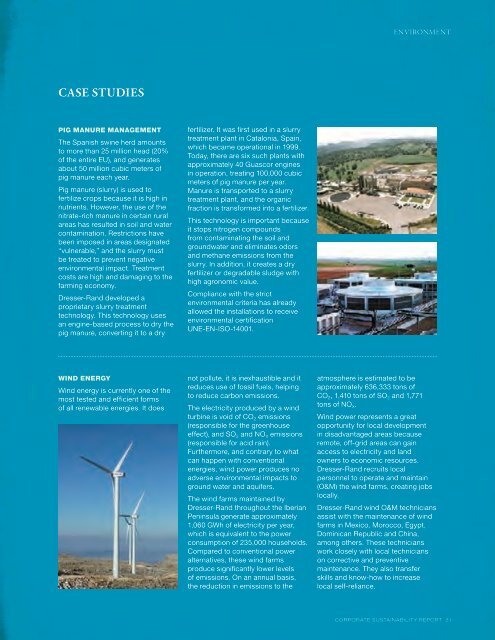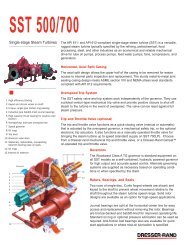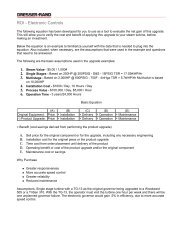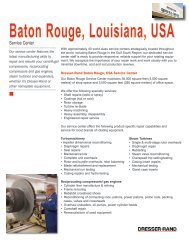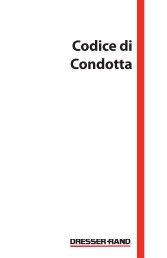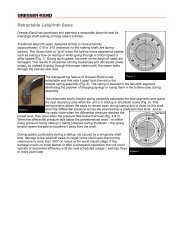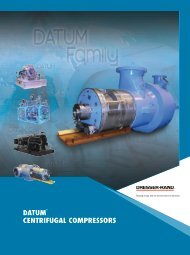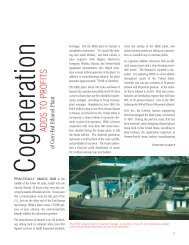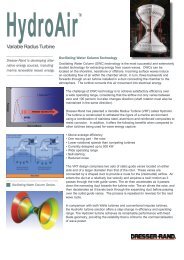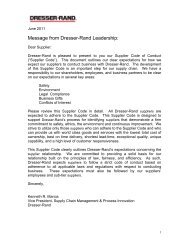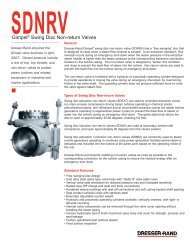case studies - Dresser-Rand
case studies - Dresser-Rand
case studies - Dresser-Rand
Create successful ePaper yourself
Turn your PDF publications into a flip-book with our unique Google optimized e-Paper software.
CASE STUDIES<br />
PIG MANURE MANAGEMENT<br />
The Spanish swine herd amounts<br />
to more than 25 million head (20%<br />
of the entire EU), and generates<br />
about 50 million cubic meters of<br />
pig manure each year.<br />
Pig manure (slurry) is used to<br />
fertilize crops because it is high in<br />
nutrients. However, the use of the<br />
nitrate-rich manure in certain rural<br />
areas has resulted in soil and water<br />
contamination. Restrictions have<br />
been imposed in areas designated<br />
“vulnerable,” and the slurry must<br />
be treated to prevent negative<br />
environmental impact. Treatment<br />
costs are high and damaging to the<br />
farming economy.<br />
<strong>Dresser</strong>-<strong>Rand</strong> developed a<br />
proprietary slurry treatment<br />
technology. This technology uses<br />
an engine-based process to dry the<br />
pig manure, converting it to a dry<br />
WIND ENERGY<br />
Wind energy is currently one of the<br />
most tested and efficient forms<br />
of all renewable energies. It does<br />
fertilizer. It was first used in a slurry<br />
treatment plant in Catalonia, Spain,<br />
which became operational in 1999.<br />
Today, there are six such plants with<br />
approximately 40 Guascor engines<br />
in operation, treating 100,000 cubic<br />
meters of pig manure per year.<br />
Manure is transported to a slurry<br />
treatment plant, and the organic<br />
fraction is transformed into a fertilizer.<br />
This technology is important because<br />
it stops nitrogen compounds<br />
from contaminating the soil and<br />
groundwater and eliminates odors<br />
and methane emissions from the<br />
slurry. In addition, it creates a dry<br />
fertilizer or degradable sludge with<br />
high agronomic value.<br />
Compliance with the strict<br />
environmental criteria has already<br />
allowed the installations to receive<br />
environmental certification<br />
UNE-EN-ISO-14001.<br />
not pollute, it is inexhaustible and it<br />
reduces use of fossil fuels, helping<br />
to reduce carbon emissions.<br />
The electricity produced by a wind<br />
turbine is void of CO2 emissions<br />
(responsible for the greenhouse<br />
effect), and SO2 and NOX emissions<br />
(responsible for acid rain).<br />
Furthermore, and contrary to what<br />
can happen with conventional<br />
energies, wind power produces no<br />
adverse environmental impacts to<br />
ground water and aquifers.<br />
The wind farms maintained by<br />
<strong>Dresser</strong>-<strong>Rand</strong> throughout the Iberian<br />
Peninsula generate approximately<br />
1,060 GWh of electricity per year,<br />
which is equivalent to the power<br />
consumption of 235,000 households.<br />
Compared to conventional power<br />
alternatives, these wind farms<br />
produce significantly lower levels<br />
of emissions. On an annual basis,<br />
the reduction in emissions to the<br />
ENVIRONMENT<br />
atmosphere is estimated to be<br />
approximately 636,333 tons of<br />
CO2, 1,410 tons of SO2 and 1,771<br />
tons of NOX. Wind power represents a great<br />
opportunity for local development<br />
in disadvantaged areas because<br />
remote, off-grid areas can gain<br />
access to electricity and land<br />
owners to economic resources.<br />
<strong>Dresser</strong>-<strong>Rand</strong> recruits local<br />
personnel to operate and maintain<br />
(O&M) the wind farms, creating jobs<br />
locally.<br />
<strong>Dresser</strong>-<strong>Rand</strong> wind O&M technicians<br />
assist with the maintenance of wind<br />
farms in Mexico, Morocco, Egypt,<br />
Dominican Republic and China,<br />
among others. These technicians<br />
work closely with local technicians<br />
on corrective and preventive<br />
maintenance. They also transfer<br />
skills and know-how to increase<br />
local self-reliance.<br />
CORPORATE SUSTAINABILITY REPORT 31


